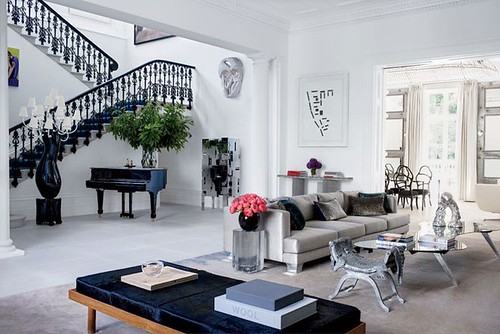London Calling!

A 19th-Century London Townhouse Gets an Avant-Garde New Look
Stately 1830s architecture meets cutting-edge art and design in a historic home updated for a collector by Francis Sultana
Text by Anthony Gardner Photography by Luke White Produced by Carlos Mota
A late-Georgian stucco mansion is not an obvious home for a collection of cutting-edge art and design—but this London residence comes with a historic connection to the avant-garde. In 1913, at the same address, leading society hostess Lady Hamilton created a showcase for the Bloomsbury Group’s newly established design collective, the Omega Workshops (the critic Roger Fry advised her on the decor, and Virginia Woolf’s sister Vanessa Bell was among the contributing artists). So it is entirely appropriate that, a century later, the property’s present owner—a Hong Kong–based art collector with strong ties to several European museums and galleries—has reintroduced a forward-thinking aesthetic to the place, this time with a wide-ranging international selection of pieces by designers like Mattia Bonetti and Martin Szekely and such artists as Adam Fuss, Gabriel Kuri, Fiona Rae, Anselm Reyle, and Keith Tyson.
What principally attracted the collector to the building was, she recalls, “the rarity of the dimensions, and the unexpectedness.” A peculiarity of the five-story mansion and its neighbors along the block, all built in the 1830s, is that their grander sides face the garden, rather than the street. “It’s very historic and unique,” she says.
The sizable apartment she occupies with her husband and two small children takes up the house’s three lowest levels. The first and second floors are grand in scale, their elaborately corniced ceilings rising to heights of 13 feet or more, while the garden level’s ceilings extend to 12 feet. This presented designer Francis Sultana and architect Thomas Croft, both based in London, with a problem and an opportunity. Though ideal for entertaining and displaying works of art, the vast rooms weren’t obviously suited to a young family, and historic-preservation regulations stipulated that the spaces couldn’t be fully partitioned to give them more intimate proportions. The challenge, the owner says, was “to create a home, not a museum.”
Sultana and Croft (who has worked for minimalist architect John Pawson) have collaborated on several projects, despite possessing rather divergent sensibilities. “Whatever I choose in terms of furniture and decoration is quite strong,” explains Sultana, “whereas Tom is the total opposite.” The owner also took an active role, and in the end a harmonious triumvirate was established. “Francis was quite maximal, Thomas was very minimal, and I was in the middle,” says the owner. “But they were both very thoughtful about not imposing their visions.” (Lighting designer Sally Storey of John Cullen Lighting also helped humanize the building’s scale.)
This article was published in the February 2013 issue of Architectural Digest.
Click here to see the page on architecturaldigest.com: https://www.architecturaldigest.com/user/emailfriend?referringPage=https://www.architecturaldigest.com/services/lookup/79410693-88ad-42d9-bccc-18acdf3337af


